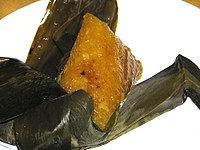Zongzi
From Wikipedia, the free encyclopedia
Zongzi
|
|||||||||||||||||
|---|---|---|---|---|---|---|---|---|---|---|---|---|---|---|---|---|---|
| Traditional Chinese: | 糭子 | ||||||||||||||||
| Simplified Chinese: | 粽子 | ||||||||||||||||
| Hanyu Pinyin: | zòngzi | ||||||||||||||||
|
|||||||||||||||||
| Zong | |||||||||||||||||
| Traditional Chinese: | 糭 | ||||||||||||||||
| Simplified Chinese: | 粽 | ||||||||||||||||
|
|||||||||||||||||
Zong, or zongzi is a traditional Chinese food, made of glutinous rice stuffed with different fillings and wrapped in bamboo or reed leaves. They are cooked by steaming or boiling. They are known in Japanese as chimaki. Laotians, Thais, Cambodians, and Vietnamese (bánh tro in Vietnamese language) also have similar traditional dishes influenced by zongzi.
Contents |
[edit] Origins
Zongzi (also known as rice dumpling) is traditionally eaten during the Dragon Boat Festival (Mandarin: Duanwu; Cantonese: Tuen Ng) which falls on the fifth day of the fifth month of the Chinese calendar (approximately early- to mid-June), commemorating the death of Qu Yuan, a famous Chinese poet from the kingdom of Chu who lived during the Warring States period. Known for his patriotism, Qu Yuan tried unsuccessfully to warn his king and countrymen against the expansionism of their Qin neighbors. When the Qin Dynasty general Bai Qi took Yingdu, the Chu capital, in 278 BC, Qu Yuan's grief was so intense that he drowned himself in the Miluo river after penning the Lament for Ying. According to legend, packets of rice were thrown into the river to prevent fish from eating the poet's body.[1] Another version states that zongzi were given to placate a dragon that lived in the river.
[edit] Description
The shape of zongzi range from relatively tetrahedral to cylindrical. Wrapping a zongzi neatly is a skill which is passed down through families, as are the recipes. Like tamale-making in Mexico and Pamonha-making in Brazil, zongzi-making was traditionally a family event with everyone helping out, but that is less common now.
While traditional Chinese zongzi are wrapped in bamboo leaves, the leaves of lotus, maize, banana, canna, shell ginger or pandan leaves are sometimes used as substitutes in other cultures. Each kind of leaf imparts its own unique smell and flavour to the rice.
The fillings used for zongzi vary from region to region, but the rice used is always glutinous rice (also called sticky or sweet rice). Depending on the region, the rice may be lightly precooked by stir-frying or soaked before using. Fillings may be sweet, with:
[edit] Ingredients
- Skinless mung beans
- Red bean paste
- Jujubes
Or savoury with fillings such as:
- Char siu (Chinese barbecue pork)
- Chinese sausage
- Chinese black mushrooms
- Salted duck eggs
- Chestnuts
- Cooked peanuts
- Green beans
- Dried shrimp
- Scallops
- Red-cooked pork[1]
- Curry Chicken
Red bean paste zongzi take a particularly long time to prepare. The red beans used for the filling must be simmered until soft, drained, skinned, and mashed into a paste that is stir-fried with sugar.
Zongzi need to be steamed or boiled for several hours depending on how the rice is treated prior to filling. Once cooked, the zongzi can easily be frozen for later consumption. Frozen zongzi are available for sale in many Chinese markets.
[edit] Variations
- Pseudo-zongzi (假粽 jia zong): Instead of glutinous rice, mochi-like balls of glutinous rice flour (so no individual grains of rice are discernible) are used to "contain" the filling of the zong. These zong are typically smaller than most zongzi and much more sticky. This is how the Hakka traditionally make their zongzi [2].
- Jianshui zong (碱水粽): The glutinous rice is treated with lye water (aqueous calcium hydroxide), which gives them a distinctive yellow colour. Jianshui zong are typically filled with sweet fillings, although some are unfilled. This is the variation that usually contain no filling and are often eaten with sugar or light syrup.
- Nonya zong (娘惹粽): A specialty of Peranakan cuisine. The zong are made in similar style with similar fillings as Southern zong, however the wrapping used are pandan leaves.
[edit] Miscellaneous
- Due to their prolonged cooking times, doneness is a constant issue with cooking zong. An old superstition says that it will not cook properly if a pregnant woman enters the kitchen while they are being steamed.
- In 2005, the earliest zongzi ever found in China was discovered in a 700 year old tomb in Dean County, Jiangxi Province.[2]
- Chinese authorities issued zongzi health warnings for the 2006 Dragon Boat Festival due to copper compounds being used to enhance the color of the leaves used for wrapping in some factories.[3][4]
[edit] See also
[edit] References
- ^ The origin of zongzi
- ^ Oldest traditional food found in 700-year-old tomb in E. China
- ^ Warning issued over toxic zongzi
- ^ China warns of poisonous Dragon Boat dumplings
[edit] External links
| Wikimedia Commons has media related to: Zongzi |




